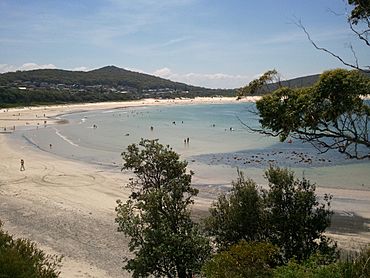Fingal Bay facts for kids
Quick facts for kids Fingal BayNew South Wales |
|||||||||||||||
|---|---|---|---|---|---|---|---|---|---|---|---|---|---|---|---|

Fingal Bay
|
|||||||||||||||
| Population | 1,635 (2021 census) | ||||||||||||||
| • Density | 175.8/km2 (455/sq mi) | ||||||||||||||
| Postcode(s) | 2315 | ||||||||||||||
| Area | 9.3 km2 (3.6 sq mi) | ||||||||||||||
| Time zone | AEST (UTC+10) | ||||||||||||||
| • Summer (DST) | AEDT (UTC+11) | ||||||||||||||
| Location |
|
||||||||||||||
| LGA(s) | Port Stephens Council | ||||||||||||||
| Region | Hunter | ||||||||||||||
| County | Gloucester | ||||||||||||||
| Parish | Tomaree | ||||||||||||||
| State electorate(s) | Port Stephens | ||||||||||||||
| Federal Division(s) | Paterson | ||||||||||||||
|
|||||||||||||||
|
|||||||||||||||
Fingal Bay is a beautiful coastal suburb located in the Hunter Region of New South Wales, Australia. It's the easternmost part of the Port Stephens Council area. The main town in the area is also called Fingal Bay, named after the small, curved bay right next to it. In 2021, about 1,635 people lived in the town.
Most of Fingal Bay is covered by the Tomaree National Park. This park protects amazing forests, coastal areas, beaches, and a large part of the Fingal headland. The suburb itself doesn't include the water of the bay, but it's right next to it.
Contents
Exploring Fingal Bay
Fingal Bay is about 1.75 km (1.1 mi) wide at its broadest point. From the mouth of the bay to the beach, it stretches about 1.3 km (0.8 mi). The northeastern side of the bay has a headland called Point Stephens. This headland is connected to the mainland by a long sand spit called Fingal Spit, which is about 900 m (2,953 ft) long.
Dangers of Fingal Spit
Crossing the Fingal Spit between the mainland and the headland can be very dangerous. At high tide, the spit is covered by strong waves. Signs on the beach warn people that some have even died trying to cross it. The waters to the northeast of the spit are known as "Fly Roads."
Southern Headland and Beach
The southwestern side of the bay is called Fingal Head, located southeast of the town. The mouth of the bay, between Point Stephens and Fingal Head, is over 1 km (0.6 mi) wide. Inside the bay, there's a lovely sandy beach that is about 1.9 km (1.2 mi) long.
History of the Bay's Name
The bay was first known as "False Bay." This was because sailors could easily mistake it for the entrance to Port Stephens. The name "Fingal Bay" first appeared on a map in 1845, which was created by Captain Phillip Parker King.
Point Stephens Headland
The headland, also known as Fingal Island, is shaped irregularly and covers about 1 km2 (0.4 sq mi). Most of this area is part of the Tomaree National Park. The headland reaches a height of 75 m (246 ft).
Connection to the Mainland
Point Stephens used to be connected to the mainland before a big storm called the "Maitland gale" in 1891. This storm changed the coastline and separated the headland.
How Point Stephens Got Its Name
The southeastern tip of the headland was named "Point Stephens" by Captain Cook on May 11, 1770. He named it after Sir Philip Stephens, who was the Secretary to the Admiralty. Sir Philip was a personal friend of Captain Cook and had recommended him for command of his voyage. Captain Cook's first choice for the name was actually Point Keppel, but he used that name later for Keppel Bay. The name "Point Stephens" first appeared on a chart made by Captain Phillip Parker King in 1845.
The Point Stephens Lighthouse
People realized a lighthouse was needed on Point Stephens as early as 1857. This was because of how close it was to the entrance of Port Stephens and the dangers the coastline posed to ships. A 21 m (69 ft) tall stone lighthouse was built in 1862. In 1973, the lighthouse keeper was replaced by an automated system that runs on solar power. The light is 38 m (125 ft) above sea level and can be seen from about 28 km (15 nmi) away.
Getting Around Fingal Bay
Port Stephens Coaches provide local bus services from Fingal Bay to nearby places like Newcastle. They also offer an express service that goes all the way to Sydney.
Heritage Sites
Fingal Bay has some important historical sites. One of them is the Point Stephens Light on Point Stephens, or Fingal Island, which is listed as a heritage site.


